Peru Diary 5
Sept 30/Oct 1/Oct 2
With the first group on their way home it was time to relax and do the
paperwork (well, having brought my laptop, not so much paperwork as
digitwork). Time to go to the cinema, which showed up my poor
Castillian - although I didn't recognise the Spanish film title the
first film turned out to be Lust, Caution and the dialogue was mostly
in Chinese. Unfortunately I couldn't read the Spanish sub-titles
quickly enough .. even when I could read the white letters against the
light background! I tried again the next night with a Peruvian film
about the destiny of two friends in a village invaded by the Shining
Path guerrillas in the 1980s - rather gruesome events against a
beautiful landscape background. The film suddenly ended - did they run
out of funds? - and text appeared on the screen, which ended with the
quote " a people who do not know their history will make the same
mistakes". Sounds good, but I prefer "Experience is like a candle, it
only illuminates the person holding it" .
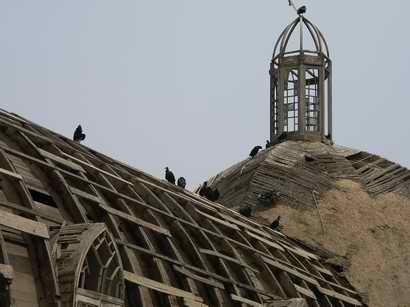
The only sightseeing I engaged in was to take a combi ride to Barranco,
the city district on the coast alongside Miraflores. This is supposed
to be the haunt of artists, but it had a very lost feel - maybe it
comes alive in the evening, judging by the number of bars and clubs
with closed doors at lunch-time when I was there. It also seemed to
have a higher than average number of turkey vultures around...Walking
back along the cliff tops to Miraflores I was struck by the number of
luxury flats built overlooking the sea - a contrast to the run-down
buildings along the main roads.
Meanwhile, back in Miraflores, preparations were in hand for a flower
festival. Booths have appeared in the Central and Kennedy parks and
stunning orchids and tropical plants (like the Heliconias we saw in the
Amazon) were being carted around. The opening is on the 2nd, but
a reception already seemed to be underway in the main tent, and a
couple of flowers were walking around on stilts...
Vultures on derelict roof of historic church, Barranco
The following day heralded the arrival of the second Ramblers group.
Apart from moving hotels, again, the day was spent in preparation, bits
of washing, eating, and finally meeting up with the Solmartour 'fixer'
Rodolpho to go to the airport to meet the group. He brought the happy
news that I would be reimbursed for the $148 I had paid out for my
Lima-Arequipa air ticket with the last group! He then stopped a
battered white taxi & we bounced off to the airport, with my knees
around my ears in the back of this tin can. There appears to be no
direct road to the airport. Every time I have been there we have taken
a different route. Every route has involved countless vicious 'sleeping
policemen', traffic lights, swerving combi buses and taxis, and miles
of slow moving dual carriageways lined with big commercial centres, car
showrooms, KFC/Pizza Hut outlets. There were also lots of 'Chifa'
- Chinese restaurants - in some areas.
Having met the group, only 14 this time, I was relieved to find that
they had been warned that the next day we would be moving on already...
Oct 3
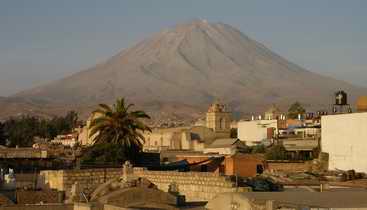 No flight problems
this time, and we were met at Arequipa airport by the guide, Hildana,
& whisked immediately to viewpoints overlooking Arequipa and the
surrounding volcanoes. The square in Yanahuara (apparently meaning
black underwear in Quechua...) was filled with booths, tables and
chairs as there was a 'gastronomic festival' on - we should have eaten
there, because in Arequipa later it took ages before all the group had
eaten, and managed to pay the bill.
No flight problems
this time, and we were met at Arequipa airport by the guide, Hildana,
& whisked immediately to viewpoints overlooking Arequipa and the
surrounding volcanoes. The square in Yanahuara (apparently meaning
black underwear in Quechua...) was filled with booths, tables and
chairs as there was a 'gastronomic festival' on - we should have eaten
there, because in Arequipa later it took ages before all the group had
eaten, and managed to pay the bill. 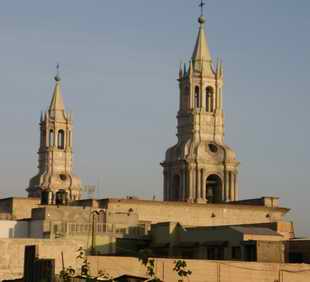
This meant a late start to the town tour, starting at the Casa de
Moral, a fine Spanish colonial courtyard house now owned by a bank
& opened to the public. It was filled with unusual furniture,
paintings and old maps, and the view from the roof as the sun was
getting lower was hard to beat - white church towers reaching over the
flat roofs of the town centre in all directions. Beyond them all the
brooding presence of the volcanoes Misti and Chachani.
By the time we explored the cathedral and square the street lights were
beginning to come on - the gathering gloom may explain why we had
difficulty seeing the figures and faces Hildana was pointing out on the
intricately carved frontage of the Iglesia de la Compania; or it
could just be our lack of imagination.
El
Misti volcano above Arequipa
Church towers in Arequipa
Oct 4
Time to move on again, and head up over the 4800m high pass to Colca
Canyon. Before going too high we stopped at Patahuasi junction for a
medicinal Coca tea with Muña and Chachama leaves. Ummmm.
En route we had an excellent (but distant) view of some
vicuñas.
Later we came across a corral of alpacas dressed up for a birthday
party. Higher still we were introduced to the humble yareta, which is a
green rock-like (to touch) plant that grows slowly (1mm a year), and
only over around 4500m altitude. Formerly used as a fuel at this
tree-less altitude, it is now a protected species. They make lovely
firm seats.....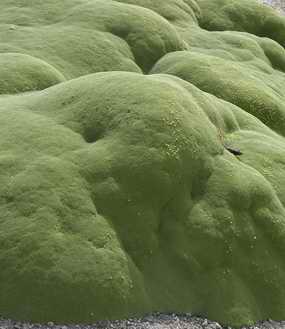
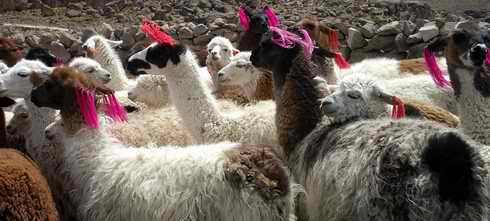
We had a picnic overlooking Chivay and the pre-Inca terraces of the
Colca valley. As a few of the group we suffering somewhat from the
altitude we headed straight for the Colca Lodge, and I then headed
straight for the hot pool for a 37° stewing session.
Yareta plant
Alpacas
in party gear
Oct 5
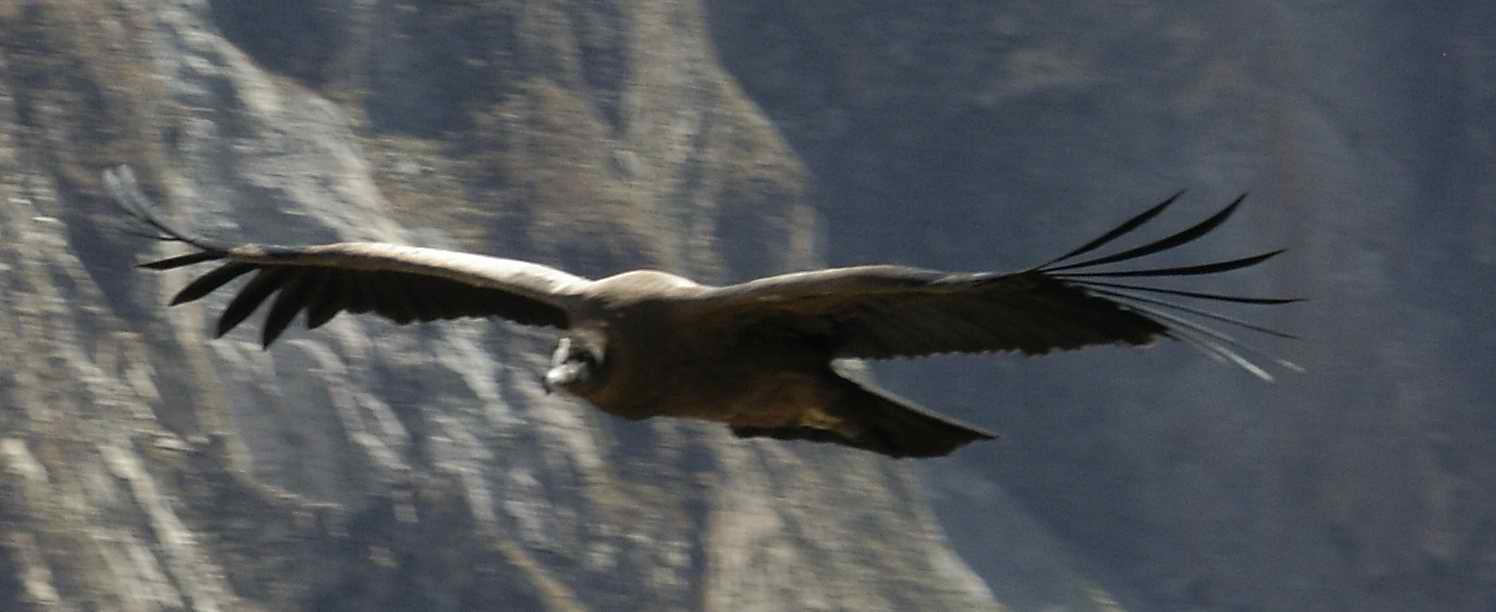 Early rising to catch
the early rising condors in Colca Canyon - and we only just made it as
several condors appeared just after we had got out of the bus. It
looked as though they were deliberately putting on a show of soaring
for our benefit as they sailed along the canyon edge in front of the
world's assembled cameras and video recorders. Wonderful! However,
having had four performing condors in the first five minutes of our
stay, the next hour and a half was a bit of a let down - only a couple
of condors appeared at half-hour intervals for a quick fly-past, then
up and away to the coast!
Early rising to catch
the early rising condors in Colca Canyon - and we only just made it as
several condors appeared just after we had got out of the bus. It
looked as though they were deliberately putting on a show of soaring
for our benefit as they sailed along the canyon edge in front of the
world's assembled cameras and video recorders. Wonderful! However,
having had four performing condors in the first five minutes of our
stay, the next hour and a half was a bit of a let down - only a couple
of condors appeared at half-hour intervals for a quick fly-past, then
up and away to the coast!
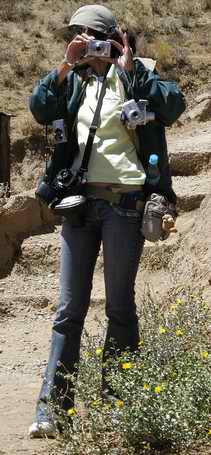
Never mind, the views down into the canyon, and up to the heights above
(with a couple of huge ice falls visible) were magnificent as we walked
for an hour back along the rim, stopping only for the obligatory group
photos taken by our guide...
Condor
sailing past
Then it was back into the bus and further along the canyon to
Cabanaconde for lunch - a long drawn out affair that is inevitable when
15 people descend on a small hotel/restaurant!
Back at the hotel whilst most of the group headed for the hot pools
five of us, with the guide, headed up to the deserted village of
Uyo-Uyo. What I hadn't realised when I visited it on my own three weeks
ago was that the walls of the various dwellings had stonework
recognisably dating from the pre-Inca, the Inca and early Spanish
periods. It was in the 17th century when the Spanish felt that the
large building, with its seven Inca-style niches, was a regional
meeting centre of power or influence against the Spanish that they
destroyed the village and moved the inhabitants to the present village
of Yanque. It was getting dark as we got back to the hotel; small
(unidentifiable) birds springing from bushes either side of the track
as we walked. The low lights marking the paths made the lodge look
quite festive in the dark.
Festooned with cameras: Hildana
taking a group photo for
everyone
Oct 6
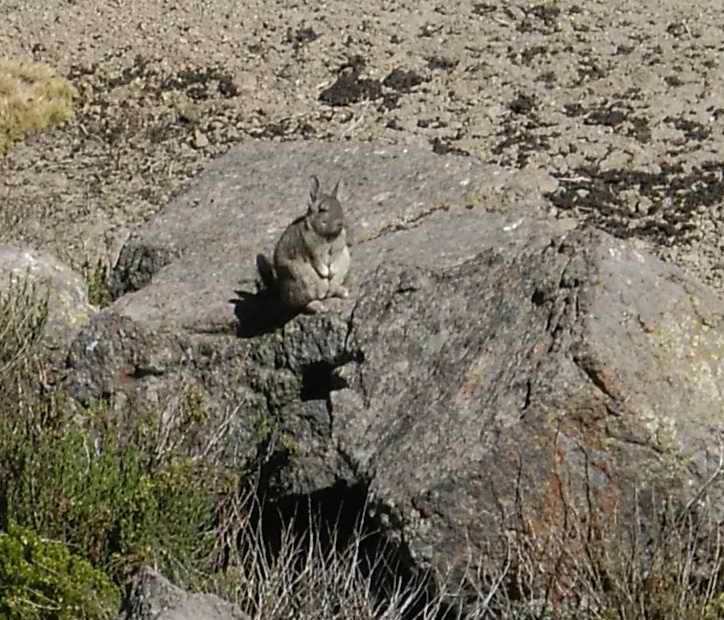 The morning started
with an small earth tremour, which I didn't feel; but I did see two
rock falls it precipitated and the two dogs at the lodge started
barking at the heavens. Then it was off again in the
tyre-tracks of the previous group to Puno. This time our guide managed
to find a vizcacha for us - a rabbit sized animal like a chinchilla. It
lives among the rocks and seems to be able to endure the climate at
4500m - it was past 10 am on a sunny morning, and the edges of the
streams were still frozen. Away in the distance a volcano was quietly
smoking away. the smudge on the horizon being complemented by the
rising brown columns of dust devils swirling over the arid land. The
landscape was a patchwork of bare rock of beige, red and white hues
with a scattering of yellow grasses (often shaped like mini fir trees)
and tola bushes - Arizona or the Karoo come to mind. Many long slow
climbs later, having passed countless lorries and trailers taking acid
to the copper mines near Cuzco, and swerved to avoid oncoming
high-speed buses, we descended onto the alteplano, the flat high
plateau surrounding the Lake Titicaca area - we were still at around
3800m. After just two days in the rural peace of Colca canyon it was
with apprehension that we passed through industrial (and rather ugly)
Juliaca and entered the spreading city of Puno - one million population
and spreading fast..
The morning started
with an small earth tremour, which I didn't feel; but I did see two
rock falls it precipitated and the two dogs at the lodge started
barking at the heavens. Then it was off again in the
tyre-tracks of the previous group to Puno. This time our guide managed
to find a vizcacha for us - a rabbit sized animal like a chinchilla. It
lives among the rocks and seems to be able to endure the climate at
4500m - it was past 10 am on a sunny morning, and the edges of the
streams were still frozen. Away in the distance a volcano was quietly
smoking away. the smudge on the horizon being complemented by the
rising brown columns of dust devils swirling over the arid land. The
landscape was a patchwork of bare rock of beige, red and white hues
with a scattering of yellow grasses (often shaped like mini fir trees)
and tola bushes - Arizona or the Karoo come to mind. Many long slow
climbs later, having passed countless lorries and trailers taking acid
to the copper mines near Cuzco, and swerved to avoid oncoming
high-speed buses, we descended onto the alteplano, the flat high
plateau surrounding the Lake Titicaca area - we were still at around
3800m. After just two days in the rural peace of Colca canyon it was
with apprehension that we passed through industrial (and rather ugly)
Juliaca and entered the spreading city of Puno - one million population
and spreading fast..
A
vizcacha pops outo see us
Back to Peru Trip Index

 No flight problems
this time, and we were met at Arequipa airport by the guide, Hildana,
& whisked immediately to viewpoints overlooking Arequipa and the
surrounding volcanoes. The square in Yanahuara (apparently meaning
black underwear in Quechua...) was filled with booths, tables and
chairs as there was a 'gastronomic festival' on - we should have eaten
there, because in Arequipa later it took ages before all the group had
eaten, and managed to pay the bill.
No flight problems
this time, and we were met at Arequipa airport by the guide, Hildana,
& whisked immediately to viewpoints overlooking Arequipa and the
surrounding volcanoes. The square in Yanahuara (apparently meaning
black underwear in Quechua...) was filled with booths, tables and
chairs as there was a 'gastronomic festival' on - we should have eaten
there, because in Arequipa later it took ages before all the group had
eaten, and managed to pay the bill. 


 Early rising to catch
the early rising condors in Colca Canyon - and we only just made it as
several condors appeared just after we had got out of the bus. It
looked as though they were deliberately putting on a show of soaring
for our benefit as they sailed along the canyon edge in front of the
world's assembled cameras and video recorders. Wonderful! However,
having had four performing condors in the first five minutes of our
stay, the next hour and a half was a bit of a let down - only a couple
of condors appeared at half-hour intervals for a quick fly-past, then
up and away to the coast!
Early rising to catch
the early rising condors in Colca Canyon - and we only just made it as
several condors appeared just after we had got out of the bus. It
looked as though they were deliberately putting on a show of soaring
for our benefit as they sailed along the canyon edge in front of the
world's assembled cameras and video recorders. Wonderful! However,
having had four performing condors in the first five minutes of our
stay, the next hour and a half was a bit of a let down - only a couple
of condors appeared at half-hour intervals for a quick fly-past, then
up and away to the coast! 
 The morning started
with an small earth tremour, which I didn't feel; but I did see two
rock falls it precipitated and the two dogs at the lodge started
barking at the heavens. Then it was off again in the
tyre-tracks of the previous group to Puno. This time our guide managed
to find a vizcacha for us - a rabbit sized animal like a chinchilla. It
lives among the rocks and seems to be able to endure the climate at
4500m - it was past 10 am on a sunny morning, and the edges of the
streams were still frozen. Away in the distance a volcano was quietly
smoking away. the smudge on the horizon being complemented by the
rising brown columns of dust devils swirling over the arid land. The
landscape was a patchwork of bare rock of beige, red and white hues
with a scattering of yellow grasses (often shaped like mini fir trees)
and tola bushes - Arizona or the Karoo come to mind. Many long slow
climbs later, having passed countless lorries and trailers taking acid
to the copper mines near Cuzco, and swerved to avoid oncoming
high-speed buses, we descended onto the alteplano, the flat high
plateau surrounding the Lake Titicaca area - we were still at around
3800m. After just two days in the rural peace of Colca canyon it was
with apprehension that we passed through industrial (and rather ugly)
Juliaca and entered the spreading city of Puno - one million population
and spreading fast..
The morning started
with an small earth tremour, which I didn't feel; but I did see two
rock falls it precipitated and the two dogs at the lodge started
barking at the heavens. Then it was off again in the
tyre-tracks of the previous group to Puno. This time our guide managed
to find a vizcacha for us - a rabbit sized animal like a chinchilla. It
lives among the rocks and seems to be able to endure the climate at
4500m - it was past 10 am on a sunny morning, and the edges of the
streams were still frozen. Away in the distance a volcano was quietly
smoking away. the smudge on the horizon being complemented by the
rising brown columns of dust devils swirling over the arid land. The
landscape was a patchwork of bare rock of beige, red and white hues
with a scattering of yellow grasses (often shaped like mini fir trees)
and tola bushes - Arizona or the Karoo come to mind. Many long slow
climbs later, having passed countless lorries and trailers taking acid
to the copper mines near Cuzco, and swerved to avoid oncoming
high-speed buses, we descended onto the alteplano, the flat high
plateau surrounding the Lake Titicaca area - we were still at around
3800m. After just two days in the rural peace of Colca canyon it was
with apprehension that we passed through industrial (and rather ugly)
Juliaca and entered the spreading city of Puno - one million population
and spreading fast..